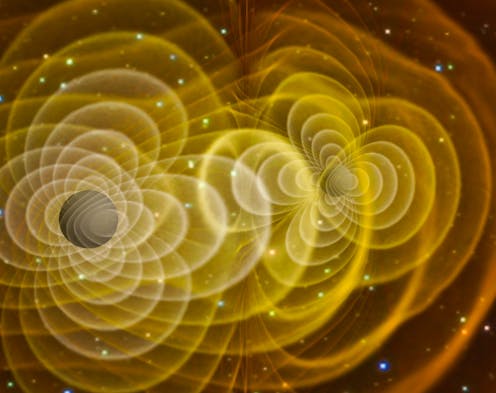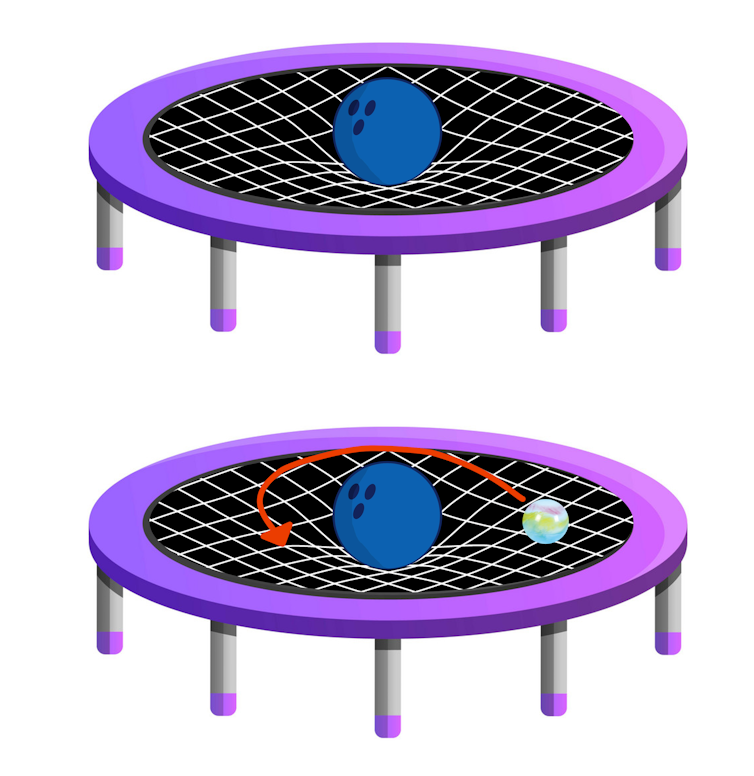
What are gravitational waves? – Millie, age 10, Sydney
What a great question Millie!
To answer this we have to travel back in time, to the year 1916. This is the year famous physicist Albert Einstein published his general theory of relativity.
Einstein had figured out how to explain gravity within the Universe using maths. Gravity is the force that keeps us on Earth, and Earth orbiting around the Sun. Until 1916 there had been many theories to try and explain what gravity was and why it exists. But Einstein suggested that gravity was the bending of something called space-time.
You can think of space-time like the fabric of the Universe. It’s what makes up the space we live in. Without it we wouldn’t have a Universe, and that wouldn’t be very fun.
Read more: Curious Kids: is it possible to see what is happening in distant solar systems now?
A space-time trampoline
Curved space-time is responsible for the effects of gravity. A trampoline is a great way for us to picture this on a flat surface.
Imagine you place a heavy bowling ball in the centre of a trampoline – its mass bends the fabric, and it creates a dip. Now, if we tried to roll a marble across the trampoline, it would roll inwards and around the bowling ball.
That’s all gravity is: the distortion of the space-time fabric, affecting how things move.

This is what Einstein’s famous equations helped to explain – how we can expect space-time to move under different conditions. We know that in the Universe, nothing stands still. Everything is always moving, and when objects speed up through space-time, they can create small ripples, just like a pebble in a pond.
These ripples are what we call gravitational waves. Our Universe is likely full of these tiny waves, like an ocean with waves moving in all different directions.
But unlike the ocean, gravitational waves are incredibly small and won’t be rocking Earth about. When first predicted by Einstein, he doubted if we’d ever be able to detect them because of how teeny tiny they should be.
I would love to know what he would think today. Not only have we detected gravitational waves, but we’ve detected 90 unique events! This is one of the biggest achievements in physics, and how they did it was nothing short of amazing.
Read more: Curious Kids: what is cosmic microwave background radiation?
Squeeze and stretch
When a gravitational wave passes through Earth, it squeezes or stretches the whole planet in the direction it travels. If we tried to measure it with something like a ruler, the ruler would appear to be the same length because the numbers on the ruler would also be stretched or squeezed, and wouldn’t change.
But scientists have a trick: they can use light, because light can only travel a certain distance over a certain time. If space is stretched out, the light has to travel a little bit farther, and takes longer. Vice versa for when space in squeezed.
The trick to knowing if space has been squeezed or stretched is to measure it in two directions, and calculate the difference. Unfortunately for us it isn’t something that is easy to measure.
The difference in the distance we’re looking for is 1,000 times smaller then a really tiny particle called a proton. To really blow your mind, our bodies have around 10 octillion protons (10,000,000,000,000,000,000,000,000,000).
It’s an insanely small change we needed to detect, but thankfully clever scientists and engineers figured out a way to do it, and you can learn more about these detectors in the video below.
Gravitational waves have given us new eyes to our Universe, allowing us to “see” things like black holes and neutron stars crashing together – because we can finally detect the tiny ripples they create.
Sara Webb does not work for, consult, own shares in or receive funding from any company or organisation that would benefit from this article, and has disclosed no relevant affiliations beyond their academic appointment.
This article was originally published on The Conversation. Read the original article.








